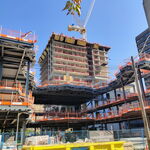The population density of the Greater Toronto Area is actually similar to that of European cities and far higher than that of other North American and Australian cities. And don't go grouping Russian cities with the rest of Europe because they are not even remotely similar.
Approx population density of selected metros 1996
Houston 6 persons per hectare
Phoenix 6
Denver 10
Perth 10
Boston 10
Detroit 11
Brisbane 12
Adelaide 12
Washington 12
Chicago 13
San Francisco 13
New York 16
Los Angeles 17
Melbourne 17
Sydney 18
Copenhagen 27
Toronto 39
Of the low density metropolitan areas that have subways serving their suburbs, Washington, San Fransisco and Atlanta the subsidies are very high. As long as Toronto is the least susidized NA major transit system, highly subsidized suburban lines would be a disaster.
The densities vary considerably around the huge metro area of Toronto. The Yonge line is successful because it follows areas of mixed uses and high densities along most of the route. If you want to have buses provide most of the service to serve the subways you better be able to increase bus service. You might not be able to do both.
Ed Drass in transit- Metro
Published January 24, 2006
TTC growth plan questioned
Despite various transit promises during the recent election, the TTC faces an immediate shortfall in this year’s day-to-day operating budget. Tomorrow, the transit commission is to decide how it will find the money needed to keep the system running.
Will a fare hike be called for? Chief general manager Rick Ducharme tells In Transit that TTC officials have whittled down the operating budget gap from $66 million to $17.5 million. The system ended up with more money than expected last year, and patronage is expected to continue rising.
He says more vehicles must be added to the streets just to counteract traffic congestion and the reduced capacity of low-floor buses. Provided the TTC board approves this and other costs, it still has to fund the remaining shortfall.
Says Ducharme, “If we had to look at a fare increase in March,†then there are two scenarios. One is raising all fares, including the Metropass, which now costs $98.75.
“If we’re holding the Metropass at today’s price ... then the numbers would show maybe a 20-cent fare increase†for tokens and tickets, he adds.
Will riders get more service to accompany these possible higher prices?
Last fall, the TTC began a long-awaited effort to increase the frequency of vehicles on certain lines. The improvements were not added during rush hour because there are not enough new buses. Instead, some service was boosted just outside peak periods, on routes where demand is strong much of the day.
“The real Ridership Growth Strategy is 100 buses for the peak, but physically I can’t get them until 2007,†Ducharme says.
After widespread cuts to bus and streetcar service in the 1990s, the TTC has hardly increased the passenger capacity of its surface fleet. Instead, officials have been treading water, focusing on funding repairs to the subway and replacements for 25-year old buses.
How does the commission plan to grow? Long-time transit critic Steve Munro intends to ask the TTC board at its meeting tomorrow. Munro is worried the strategy to bring more buses and streetcars to riders across the city has been “hijacked by the subway advocates.†He writes, “We continue to encourage fantasies about a subway network that will not be built for at least two decades while the basic system is starved for funding, vehicles and service.â€
Munro warns that the city needs to examine “what a real ridership growth strategy looks like. (Mayor) David Miller has been resting on his laurels — those 100 new buses — far too long. Where are the next hundred and the hundred after that — which, by the way, only gets us back to 1990 fleet levels.â€
To serve the steadily growing city beyond the amount of transit service it had 16 years ago “takes even more vehicles,†Munro adds. He says that instead of treading water and shaving budgets, the TTC must state clearly how it will grow and how much that growth will cost.




